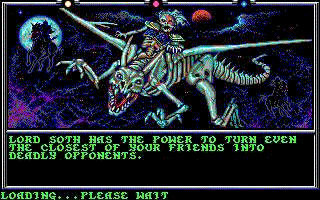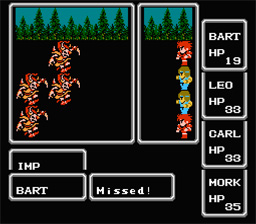
What I am considering today is the way that supporting characters really fill out RPG games. In the first place there are simple NPC characters that the player has no direct influence on. They can be considered as much a part of the atmosphere as the artwork or the music. However, they can be used to inspire the emotions and get the player really involved in the story. Here I have to mention Champions of Krynn once again because I feel it has one of the best examples of this I've ever played through. As the game unfolds you get to know an honorable knight name Sir Karl.

Supporting characters are also used to fill out the “party” in RPG games. This particular aspect has changed a great deal over the years. When we look at games like Bard's Tales and Final Fantasy we see the party represented as nothing more than a combat group. When anyone talks to the party they are talking to you, the player. They don't talk to party member A and then party member B, they just talk to the entire party. The part has only one personality and, for all intents and purposes, might as well be one person with four to six bodies. Even this unarguably added something to the atmosphere, however. You ended up with fighters and wizards and thieves that each had their own skills even if they didn't have their own voices. In many games you could customize the look of these characters and at least make believe that your party had more than one person. In fact, we used to play Final Fantasy as a multi-player game. We would each pick a character and then announce what we wanted “our guy” to do in combat. It certainly added a great deal to the game.

As time went by this idea expanded. We began to see games with a single main character who would gather a party of actual NPCs with them as they traveled along. Here I can't help but mention Bio-Ware. One of the first games I ever played with this kind of main character/NPC party members formula was Baldur's Gate. As soon as think of that game I think “Go for the eyes, Boo!” The party members had personalities, they had goals, they were full fledged characters. There were even side quests related to what was going on in these character's fictional lives. You could help them out as if you were helping a friend. This idea was expanded on with games like Knights of the Old Republic where you had a real influence on your party as the game played out. Wherever they started from they were going to end up more like you were by the end of the game. Were you going to be a hero and inspire them to be people of moral courage or were you going to be the villain and teach them all to look out for number one? (This choice between good and evil is actually another element in RPG games, but we'll touch on that when we get fully into RPGs.) Filling out the NPCs in this way made them feel more like real people and, as a result, made the game world feel more deep and real. For RPG games at least, these supporting characters added a great deal to the atmosphere.
I've run long again... In the next post I'm going to try to get back to the roots of the thing and take a look at something that applies to all games. This tangent just sort of popped up.
If you guys like you can follow me on Facebook:
My Facebook
Also please feel to drop by the forums and say hello:
CC Forums
Again, great post!
ReplyDeleteI am sure there are some games that do this (I have played none though), where an actual supporting NPC could die because of something you did or didn't do. The rest of the game you could have a disadvantage etc. This would give the player much more "feeling" for the NPC.
I did play Heavy Rain, not exactly the same thing.